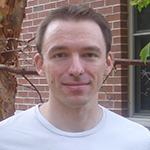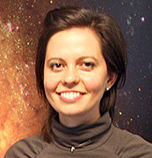*Tech = Technological Institute (2145 Sheridan Road)
**Db = Dearborn Observatory (2131 Tech Drive)
Summer Quarter 2016
| Date/Time | Visitor | Host | |
| Aug. 5 Tech F227A 11:00am |
 |
Evan Schneider In an era of increasingly complex computer architectures, codes that take full advantage of available computational power are essential. Leveraging the power of today's supercomputers will allow numerical simulations to continue to provide new theoretical insights across a broad range of topics in astrophysics, including the formation and evolution of galaxies. In this talk, I will discuss the code Cholla, and the particular problem within galaxy evolution that I am tackling with it. Cholla is a new hydrodynamics code that I have written and developed to harness the power of the graphics processing units (GPUs) responsible for much of the speed of modern supercomputers. Using Cholla, I have run a set of extremely high resolution simulations of the interaction between cool and hot gas in multiphase galactic winds. The results of these simulations suggest that mass-loading of the warm and hot phases of galactic winds is a highly efficient process. Additionally, I find that similar amounts of mass and momentum are incorporated into wind phases across a broad range of densities and temperatures. Both findings have broad implications for our current theories regarding wind expulsion and recycling that ideally can be leveraged in the future to improve cosmological simulations. |
Claude-André Faucher-Giguére |
Spring Quarter 2016
| Date/Time | Visitor | Host | |
| Apr. 13 Tech F210 2:00pm |
 |
Ethan Vishniac Magnetic fields are ubiquitous in the universe, with significant power on the size of the object that contains them. This includes planets, stars, and the disks of the galaxies. Conventional treatment, using mean field dynamo theory in which magnetic field growth is driven by kinematic helicity, "twistiness", of the underlying fluid turbulence, fails to explain observations of stellar magnetic fields. There are also strong theoretical arguments against its application to realistic systems. I will show how the transport of magnetic helicity in turbulent rotating systems provides a natural mechanism for the rapid growth of large magnetic fields. This leads to a generic prediction for the strength of stellar magnetic fields as a function of rotation rate which matches observations. |
Fred Rasio |
| May 12 Tech F160 11:00am |
 |
B-G Andersson The SOFIA project flies a significantly modified Boeing 747SP, carrying a 2.7m telescope, into the stratosphere 3-4 times a week to perform astronomical observations, primarily in the mid- to far-infrared. The observatory is now in the middle of executing Cycle 4 of its general user observations, employing all the first generation instruments, and covering all areas of astronomy from Solar System studies to extra-galactic astronomy. The Cycle 5 Call for Proposals was released at the end of April, offering all first and second generation instruments, including the Far-IR polarimeter HAWC+. I will review the status of the project and provide some science highlights from the first few observing cycles. |
Giles Novak |
| May 23 Tech F160 12:00pm |
 |
Jonathan Stern A vital ingredient in our theoretical understanding of AGN-driven galactic winds is the nature of the physical mechanism which accelerates them, such as radiation
pressure on dust grains or the ram pressure of an expanding hot gas bubble. I
will demonstrate that the nature of the acceleration mechanism can be constrained
from the ratios of emission lines which originate from the cool (T~10^4K) gas
illuminated by the AGN. I will then show that observed line ratios in UV-selected
quasars suggest that radiation pressure dominates at all scales (0.1 pc -- 10 kpc).
I will demonstrate that this result is apparently in conflict with the large
momentum outflow rates measured by many previous studies, and discuss how this
conflict might be resolved. |
Claude-André Faucher-Giguère |
| Jun. 2 Dearborn 23 3:00pm |
 |
Juan Diego Soler Pulido ESA's Planck satellite has produced the first all-sky map of the
polarized emission from dust at submillimetre wavelengths. Compared
with earlier ground-based and balloon-borne observations this survey
is an immense step forward in sensitivity, coverage, and statistics.
It provides new insight into the structure of the Galactic magnetic
field, as well as the first statistical characterization of one of the
main foregrounds to CMB polarization. |
Giles Novak |
Winter Quarter 2016
| Date/Time | Visitor | Host | |
| Jan. 11 Tech F160 12:00pm |
 |
Tim Brandt Advances in adaptive optics and infrared instrumentation now enable us to see young exoplanets millions of times fainter than their host stars. By collecting photons emitted by these worlds, imaging allows us to measure the chemistry and physical states of their atmospheres. Now, a new generation of experiments is combining upgraded adaptive optics with integral-field spectrographs (IFSs) to discover and characterize fainter worlds closer to their host stars. I will present the results of recent high-contrast surveys and the scientific promise of this new generation of instruments, with a particular focus on the CHARIS IFS for the Subaru telescope. CHARIS will be the only instrument of its class in the northern hemisphere and will have the broadest spectral coverage of any high-contrast IFS; it will provide unique sensitivity to close-in exoplanets and present new data analysis challenges. CHARIS is now being built and will begin operations this summer. It will commence its first two year, 20 night survey in early 2017, taking spectra of giant exoplanets and searching about 100 stars for new companions. |
Vicky Kalogera |
| Jan. 14 Tech F160 11:00am |
 |
Ian Stephens The role of magnetic fields during star formation at all scales has been a heated topic for decades. The magnetic field morphology can be discerned from polarized light emitted from dust grains. In this talk I will discuss the current observational constraints on the magnetic field morphology at the scales of star-forming filaments and at the scales of protostellar outflows and disks. The current constraints are very limited, but large polarimetric surveys will finally be possible within the next couple years. Specifically, ALMA, SOFIA, and BLAST have just been upgraded to probe the magnetic field morphology. These new results will answer fundamental questions about the role of magnetic fields during the star formation process from scales of molecular clouds (10s of pc) to the protostellar disks (10s of AU). |
Giles Novak and Farhad Yusef-Zadeh |
| Jan. 19 Tech F160 4:00pm |
 |
Jennifer Yee Small, rocky planets at a few AU are noticeably absent from the census of exoplanets taken by radial velocity and transit surveys (e.g. Kepler). Unlike other techniques, microlensing has the unique ability to find such planets and provides a vital component of a complete exoplanet census. Over the next decade, we will see microlensing planet discoveries reach a scale comparable to results from radial velocity and transits. I will discuss microlensings potential for revolutionizing our understanding of exoplanets, with a particular focus on the Spitzer microlensing parallax program, the KMTNet project, and the upcoming WFIRST microlensing mission. |
Vicky Kalogera |
| Jan. 22 Tech L324 2:00pm Joint Seminar with EECS |
 |
Greg Mosby To study the effect of supermassive black holes (SMBHs) on their host galaxies it is important to study the hosts when the SMBH is near its peak activity. This can be done by investigating the host galaxies of high luminosity quasars by obtaining optical spectra at positions offset from the nucleus where the relative contribution of the quasar and host are comparable. However, at these extended radii the galaxy surface brightness is low and the resulting spectrum has such low S/N that it hinders analysis with standard stellar population modeling techniques. To address this problem, we have developed a method that can recover galaxy star formation histories (SFHs) from rest frame optical spectra with S/N ~ 5 Å^-1. We use the machine learning technique diffusion k-means to tailor the stellar population basis set, composed of 4 broad age bins, and it is successful in recovering a range of galaxy SFHs. We use synthetic data to compare results of our novel method with previous techniques. Our new method has the advantage in recovering information from QHGs and could also be applied to the analysis of other low S/N galaxy spectra such as that typically obtained for high redshift objects and integral field spectroscopic surveys. To extend our work done in the optical, the use of the next generation NIR spectrographs will be crucial. I introduce the Robert Stobie Spectrograph (RSS) on the Southern African Large Telescope (SALT) and its NIR arm being built at the University of Wisconsin-Madison. We have made significant progress in the optimization of the detector system using a H2RG HgCdTe array with the SIDECAR ASIC and the IUCAA ISDEC controller card. Specifically, we have tuned the SIDECAR ASIC to achieve a CDS read noise of < 20 e- for the detector system in our test dewar for a readout speed of 200 kHz. Testing our science grade detector in the instrument dewar is nearing completion and includes measurement and characterization of persistence. |
Mel Ulmer and Hooman Mohseni |
| Jan. 25 Tech F160 12:00pm |
 |
Branimir Sesar In the next five years the Galactic astronomy is poised for significant breakthroughs, fueled by an unprecedented increase in the quality and quantity of astrophysical data provided by surveys such as Pan-STARRS1, Palomar Transient Factory, Zwicky Transient Facility, and GAIA. However, it is important to keep in mind that these surveys provide catalogs, not answers. I will show how time-domain data sets, machine learning techniques, and forward-modeling of data can be used to provide valuable insights on (1) the accretion history of the Milky Way, (2) the number of faintest Milky Way satellites, (3) the Galactic potential, and (4) the nature of a mysterious stellar stream. |
Vicky Kalogera |
| Jan. 27 Tech F160 4:00pm |
 |
Ryan Foley Type Ia supernovae (SNe Ia) are superb distance indicators and are used to map the expansion history of the Universe. In the last millennium, astronomers used observations of SNe Ia to find that the Universe's expansion is currently accelerating. This discovery resulted in the Nobel Prize for Physics in 2011. Since this initial discovery, we have used SNe Ia to loosely constrain the nature of "dark energy," which drives the accelerated expansion. To improve our dark energy constraints beyond our current basic understanding, we must design new and better SN surveys and techniques. I will present the Foundation Supernova survey, a new high-fidelity, low-redshift (z < 0.1) SN survey started in 2015 that will replace the current heterogenous low-redshift sample and reduce the (currently) largest uncertainties for SN cosmology. I will describe the survey, our implementation, and first results. I will present the "velocity-color relation" and show how we can significantly improve the distance precision of SNe Ia. I will also discuss the next major leap in SN cosmology, WFIRST, which will launch in about a decade. I will show the first simulations of the WFIRST SN survey and make some suggestions for how to further improve this mission. With the combination of the Foundation survey, WFIRST, and new physical understanding like the velocity-color relation, SNe Ia will continue to be a premier cosmological probe, continuing the legacy started decades earlier. |
Vicky Kalogera |
| Feb. 1 Tech F160 12:00pm |
 |
Raffaella Margutti Observations are drawing a complex picture of the latest stages of massive stars evolution and their explosions. In this seminar I concentrate on one among the least understood aspects of stellar evolution, adopting an observational perspective: How do massive stars loose a significant fraction of their mass in the years preceding the explosion? I address this question by taking advantage from panchromatic observations of two remarkable explosions: (i) the puzzling, double explosion of SN2009ip in 2012; (ii) and the normal envelope-stripped SN2014C, which experienced a dramatic metamorphosis and evolved from Type I into Type II supernova over a timescale of a few months, thus violating the supernova classification scheme that hat has existed for decades. |
Vicky Kalogera |
| Feb. 25 Tech L324/348 3:00pm |
 |
Jamil A. Shariff The standard Big Bang cosmological model + inflation is able to explain nearly all of the features of our observable universe with remarkable precision. However, direct evidence of inflation remains elusive, and much about the inflationary paradigm is still a mystery. What physical mechanism drove inflation, and at what energy scales did this occur? In this talk I will relate the story of Spider, an ambitious balloon-borne experiment designed to detect B-modes of polarization in the Cosmic Microwave Background on degree angular scales. If present, these features would be a signature of the primordial gravitational waves predicted to have been produced by inflation in the early universe. Spider had its first long-duration balloon flight around Antarctica in January 2015. Using vivid visuals, I will illustrate the Antarctic adventure and the vagaries of ballooning. I will conclude by describing the progress of the analysis of data from the first flight, which is well underway. |
Giles Novak |
Fall Quarter 2015
| Date/Time | Visitor | Host | |
| Sept. 15 Tech F160 4:00pm |
 |
Adrian Hamers We present a new efficient method to study the long-term dynamics of hierarchical multiple systems such as high-multiplicity stellar systems and multiplanet systems, without restrictions on the number of bodies nor on the hierarchical configuration. We apply this method to hierarchical quadruple systems consisting of a hierarchical triple orbited by a fourth body, in different contexts. First, we consider the general dynamics, and we characterise the behavior of the system in terms of a ratio of Kozai-Lidov (KL) time-scales applied to different binary pairs. Second, we apply the method to explain the currently observed lack of transiting circumbinary planets around short-period binaries. Finally, we present preliminary integrations of multiplanet systems, in which secular chaos gives rise to high eccentricities and tidal shrinkage in the innermost planet's orbit, giving a pathway for producing Hot Jupiters. Our new method allows for much faster and longer integrations compared to previous direct N-body integrations, making it an excellent tool for better understanding the conditions for producing Hot Jupiters in multiplanet systems through secular chaos. |
Fabio Antonini |
| Oct. 8 Tech F160 2:00pm |
 |
Andrew W. Smith The last 10 years have seen a dramatic explosion of important science results from space based instruments (~0.3-300 GeV) such as Fermi-LAT and AGILE, as well as ground based instruments (~100-5000 GeV) such as VERITAS, HESS, and MAGIC. These instruments have provided an in-depth exploration of particle acceleration in the the most energetic known cosmic sources (supernova remnants, gamma-ray bursts, pulsars, AGN, and the center of our own Galaxy), as well as providing important clues to the mystery of high energy cosmic ray origins. In this talk I will review the most important recent results from these instruments as well as providing a preview of the next generation of both ground and space based gamma-ray observatories. The future for ground based instruments is already being cemented with the completion of the HAWC array in Mexico, as well as the upcoming CTA array planned for both the Northern and Southern Hemispheres. The successor to Fermi-LAT is also in the works, with several mature mission concepts progressing forward already. I will review some of these concepts and provide an outlook for the future of this exciting and dynamic field. |
Farhad Yusef-Zadeh |
| Nov. 11 Tech F160 2:00pm |
 |
Tuguldur Sukhbold Nucleosynthesis, light curves, explosion energies, and remnant masses are calculated for a grid of supernovae resulting from massive stars with solar metallicity and masses between 9-120 solar masses. The full evolution is followed using an adaptive reaction network of up to 2000 nuclei. A novel aspect of the survey is the use of a one-dimensional neutrino transport model for the explosion. This explosion model has been calibrated to give the observed energy for SN 1987A and Crab supernova. As a result of using a calibrated central engine, the final kinetic energy of the supernova is variable and sensitive to the structure of the presupernova star. Many progenitors with extended core structures do not explode, but become black holes, and the masses of exploding stars do not form a simply connected set. The resulting nucleosynthesis agrees reasonably well with the sun provided that a reasonable contribution from Type Ia supernovae is also allowed, but with a deficiency of light s-process isotopes. The resulting neutron star IMF has a mean gravitational mass near 1.4 solar masses. The average black hole mass is about 9 solar masses if only the helium core implodes, and 14 solar masses if the entire presupernova star collapses. Only ~10% of supernovae come from stars over 20 solar masses and some of these are Type Ib or Ic. Some useful systematics of Type IIp light curves are explored. |
Ron Taam |
| Nov. 16 Tech F160 12:00pm |
 | John Tobin Disks and multiple star systems are thought to form early in the star formation process. Conservation of angular momentum enables the formation of protostellar disks; protostellar companions can also form if the disk is gravitationally unstable. However, theory and simulations have suggested that large, massive disk formation may be difficult due to removal of angular momentum by magnetic fields. Observations are now sensitive enough to begin testing these predictions, and Keplerian disks have been discovered around newly formed star systems. However, the numbers of Keplerian disks remain small and the frequency of companion protostars on scales < 150 AU is poorly known. To greatly expand our knowledge on the frequency of disks and multiplicity, I am leading a 264 hour VLA large program to observe all protostars in a single star forming region, the Perseus molecular cloud (d 230 pc, N 80), with a spatial resolution of 15 AU. With these data, we are identifying new protostellar disk candidates and closer multiple systems than have ever been previously identified. We have found evidence for a bimodal distribution of protostar separations, suggesting that multiple formation mechanisms are acting on different scales. Finally, we also see indications of evolution in the separation distribution for younger protostars relative to those that are more-evolved. These results open the door to expanded multiplicity and disk surveys to determine if the trends found in Perseus are applicable to other star forming regions. |
Farhad Yusef-Zadeh |
| Nov. 23 Tech F160 12:00pm |
 |
Morgan MacLeod How do close neutron star binaries form? Many aspects of our understanding of the complex channels through which compact binaries form remain uncertain. This talk focuses on a crucial phase in the formation of close binary pairs of neutron stars: a common envelope episode. During the common envelope phase, one star evolves to engulf its companion in a shared gaseous envelope. Before this envelope is ejected, drag forces pull the two stellar cores into a tighter orbit. But the neutron star can also accrete from the surrounding gas. This talk explores the hydrodynamics of the common envelope phase in order to model the metamorphosis of the neutron star and the binary orbit. |
Fabio Antonini |
Past CIERA Special Seminars